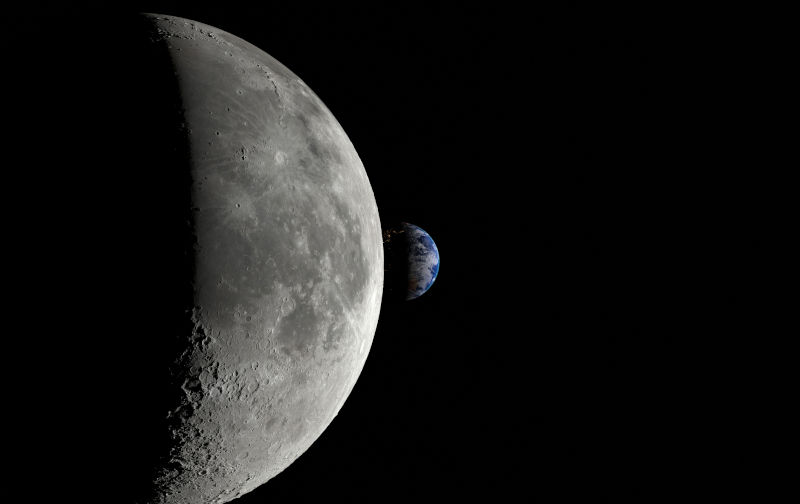US trade restrictions may eclipse UAE's moon plans
May 27, 2023
Recent reports indicate that the United Arab Emirates Rashid 2 rover planned for Chinas Change 7 mission to the moon in 2026 has hit an American speed bump. This ambitious mission is merely the next in the impressive Change lunar series. It includes a moon orbiter, a lunar lander, a so-called hopper that can move from one part of the moon to another in leaps and bounds, the UAE rover, and an in-orbit relay satellite for effective communication with Earth.
It will also host more than a dozen scientific instruments expected to furnish international scientists with a treasure trove of data for up to a decade. This mission is also intended to pave the way for the construction of a China-led international moon base by 2035.
So how serious this latest problem is remains to be seen. It depends on the essential nature of the United States-sourced high-tech components intended for the rover and whether alternative suppliers or producers of the specialised components needed can be made available within the necessary time frame.
It is the current geopolitical climate and supersensitivity concerning the perceived risks of unsanctioned technology transfers from the US to certain countries including China under the 1976 International Traffic in Arms Regulations (ITAR) that has potentially scuppered the UAEs plans. This set of regulations bans even the most common US-built technology being launched on any Chinese rocket.
These outdated actions are likely to be self-defeating in the long run in the same way the ill-conceived US Congress 2011 Wolf Amendment prevented China from joining the International Space Station (ISS). If such international cooperation and engagement with China in a pragmatic partnership like the ISS had proceeded then this may even have made the current, emerging geopolitical tensions less likely, given the mutual trust this may have promoted at the highest levels. Perhaps today we would have a much more reasonable international relationship around the ISS.
In the end, this amendment and the more rigorous implementation of ITAR has simply spurred China to massive investment in its homegrown spacefaring capacity, technology and programs. The impact is being even more broadly addressed as the recent world-leading surge in Chinese-based research papers, patents and advances across many fields of science makes clear. This increasing self-reliance has culminated in a series of remarkable Chinese achievements in space over the last few years. It is in an accelerating and inexorable program of major advancement in space technology and ambitious space and planetary missions. This is exemplified by a series of major milestones since 2019, including a world-first landing mission to the far side of the moon (Change 4), a fully automated lunar sample return mission of 2 kilograms of moon rock (Change 5) and a complicated but successful first-time Mars rover mission called Tianwen 1 (Heavenly Questions). This Chinese Mars mission by the NASA-equivalent China National Space Administration amazingly consisted of six spacecraft: an orbiter, two deployable cameras, a major lander, remote camera, and, importantly, the Zhurong rover. They all worked the first time. Finally, we have the recent completion of the preliminary configuration of the highly successful Chinese Space Station (CSS) Tiangong (Sky Palace).
Indeed, it is the very success of the CSS that has spurred NASA and its partners to prolong the lifetime of the ISS that was originally due to de-orbit in 2024. Without this the CSS would be the only space station game in town. This was deemed by the US as unacceptable. In an interesting counterpoint to the Wolf Amendment and the restrictive ITAR, the Chinese are very open to international collaboration and indeed welcome it as their recent 2021 white paper, Chinas Space Program: A 2021 Perspective, makes clear. This is supplemented by their support of the UNs key role as the main international platform for the proper governance and regulatory framework for outer space and cooperation for all humankind.
Furthermore, there is much more to come, including a Chinese moon base by 2035.
So this latest problem for the UAEs Rashid 2 moon rover could have significant knock-on effects for their very ambitious national space endeavours (not forgetting there is currently a UAE astronaut onboard the ISS). It could lead to unexpected consequences for a commercially very international and outward-looking state. So this should be seen in this context. There are even recent US commentaries that see application of the ITAR protocols as unhelpful, out of date and with rapidly diminishing relevance, and which is self-defeating in terms of harming American industrial space industries. The stated intention is to protect American technological pre-eminence, even when applied to this UAE moon rover mission. The fear is that once high-tech components intended for the Rashid 2 rover find their way to China prior to launch, they will be back-engineered and copied. However, the more likely outcome now is a rapid development of equivalent Chinese or even European and Japanese equivalent technologies for projects and missions that will no longer need US-made components in the future. This will further turbocharge international innovation, independence and nonreliance on US tech whose use is seen as increasingly restrictive and controlling of global national interests just as for the rapid emergence and success of the CSS itself and, I suspect, for the Chinese semiconductor and chip industries too.
Republished from CHINA DAILY HK EDITION May 24, 2023
